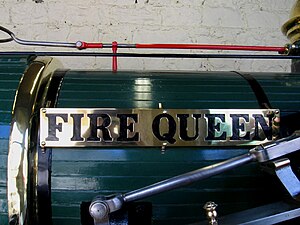Fire Queen and Jenny Lind
| Fire Queen and Jenny Lind | |
|---|---|
|
Fire Queen nameplate
|
|
| Number: | 2 |
| Manufacturer: | Horlock and Company |
| Year of construction (s): | 1848 |
| Retirement: | 1880s |
| Type : | B n2 |
| Gauge : | 1219 mm |
Fire Queen and Jenny Lind were the first locomotives on the Padarn Railway in the Dinorwic slate quarry in Wales .
history
The so-called Padarn Railway was the connecting line running along the Llyn Padarn between the actual quarry and the company's own port of Port Donorwic in the village of Y Felinheli . Unlike the rest of the quarry and port rail network, which had a gauge of 22.75 inches (578 mm), the connecting line was built in the gauge of 4 feet (1219 mm). This made it possible to piggyback four small wagons with slate plates on a transport wagon.
The Padarn Railway was opened at the beginning of the 1840s and replaced an older connecting line built in 578 mm gauge. At first it was operated by horses, but two steam locomotives were put into operation as early as 1848. They came from the Horlock and Company , which has not built any other locomotives before or after. In the quarry itself, i.e. on 578 mm gauge, locomotives were only used from around 1870.
Fire Queen and Jenny Lind remained in service until the 1880s, when they were replaced by three tank locomotives built by Hunslet . Jenny Lind was scrapped in 1882, but Fire Queen survived in a storage shed until the quarrying ceased in 1969.
Today the Fire Queen is in the Penrhyn Castle Railway Museum . It is the only remaining locomotive on the Padarn Railway.
technical features
In addition to the rare gauge, Fire Queen and Jenny Lind were also unusual in their construction. Although they were designed as freight locomotives, they were based on the patent of Thomas Russell Crampton (whose wife was friends with the opera singer Jenny Lind ) and were probably also designed by himself. Crampton's patent provided for a drive wheel set with a relatively large diameter for high speeds located behind the standing boiler , but unlike the classic Crampton locomotives , the two Horlock machines had two coupled wheel sets, with the front wheel set running under the smoke chamber.
The resulting relatively large wheelbase made it possible to arrange the cylinders inclined between the wheel sets; the connecting rods were inside the coupling rods . The locomotives did not have a frame; The cylinder and axles were attached directly to the boiler. The space gained in this way allowed the use of a standard gauge boiler on the narrow-gauge locomotive. The control of the type Stephenson was driven by the front axle, and - the first time ever - operated by means of a control spindle. As was common at the time, the feed pumps were driven mechanically via the crossheads . The supplies were housed on a two-axle tender .
Individual evidence
- ↑ Information on Crampton's private life ( memento of the original from November 20, 2012 in the Internet Archive ) Info: The archive link was inserted automatically and has not yet been checked. Please check the original and archive link according to the instructions and then remove this notice.
- ^ The Industrial Railway Record - Fire Queen .
